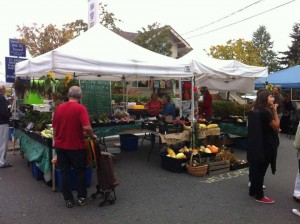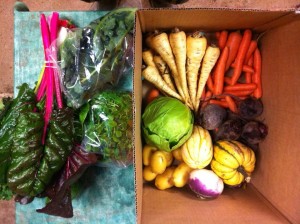We all do it and most of the time, we do it several times a day … eating food, cooking it, buying it, and sharing it with family and friends. Most of the time, it comes in quick bites and the more convenient the better. Many people lead busy lives that don’t include time to sit down and enjoy a meal, instead choosing to eat on the run or practicing distracted eating while performing a handful of tasks at once. Maybe it doesn’t need to be like that. Give it time, time to think, time to choose, time to eat and enjoy. How much importance do you place on the food you put in your body every day? What thought do you give to the choices you offer at mealtime for your family?
 What do eating sustainable foods and taking time to eat have in common? When we start to pay attention to where our food comes from and look for more sustainable food sources, this can make a big impact economically and environmentally, as well as for your own health. You will find that you appreciate the freshness and flavour that comes from local produce, especially organically grown foods. Organically grown produce provides a higher concentrations of nutrients when compared to conventional produce. Conventional produce is exposed to many synthetic and petroleum-based fertilizers, as well as hazardous pesticides and herbicides. Check out the Environmental Working Group’s ‘Dirty Dozen’ for more information on this topic. Conventionally grown produce on industrial farms has led to soil degradation and nutrient loss in crops. By choosing to buy local and organic, you are promoting better growing practices and healthier farming, from the field to your fridge.
What do eating sustainable foods and taking time to eat have in common? When we start to pay attention to where our food comes from and look for more sustainable food sources, this can make a big impact economically and environmentally, as well as for your own health. You will find that you appreciate the freshness and flavour that comes from local produce, especially organically grown foods. Organically grown produce provides a higher concentrations of nutrients when compared to conventional produce. Conventional produce is exposed to many synthetic and petroleum-based fertilizers, as well as hazardous pesticides and herbicides. Check out the Environmental Working Group’s ‘Dirty Dozen’ for more information on this topic. Conventionally grown produce on industrial farms has led to soil degradation and nutrient loss in crops. By choosing to buy local and organic, you are promoting better growing practices and healthier farming, from the field to your fridge.
 Transportation plays a huge part in sustainable eating. Have you ever thought about what it takes to bring food from Chile, Australia or even California? A huge percentage of our produce is brought to the Island from California, all the while creating more waste and pollution. Food that you buy from your local farmer’s market is grown on the other side of town or possibly just down the road. And don’t forget that when you are buying locally, you are supporting a local food producer, not a large food corporation.
Transportation plays a huge part in sustainable eating. Have you ever thought about what it takes to bring food from Chile, Australia or even California? A huge percentage of our produce is brought to the Island from California, all the while creating more waste and pollution. Food that you buy from your local farmer’s market is grown on the other side of town or possibly just down the road. And don’t forget that when you are buying locally, you are supporting a local food producer, not a large food corporation.
Ever think about going meatless for a day? Meat production causes an estimated 18% of greenhouse gases; that’s more than all global transportation combined. A third of grain and 90% of soy produced goes towards animal feed, which is mostly conventionally grown with GMOs. Reducing the amount of meat in your diet can also help promote healthy living and weight loss, not to mention the amount you can save at the grocery store. When you do include meat in your diet, try to include local meat that is pasture raised. These products tend to be of much higher quality and include a larger nutrient base. Pasture raised animals also have a better quality of life than animals raised on industrial meat farms.
 Food is medicine. What we put in our bodies now can prevent countless ailments and disease as we age. When I am feeling under the weather, the first thing I look at is what I have been eating recently. Most processed foods are stripped of much of their nutritional value or can include preservatives and additives that our bodies don’t know what to with. If we can start including more whole nutrient dense foods, our vitality will increase. Look for foods like berries, apples and rich dark greens that provide precious antioxidants and minerals that can help supercharge our bodies.
Food is medicine. What we put in our bodies now can prevent countless ailments and disease as we age. When I am feeling under the weather, the first thing I look at is what I have been eating recently. Most processed foods are stripped of much of their nutritional value or can include preservatives and additives that our bodies don’t know what to with. If we can start including more whole nutrient dense foods, our vitality will increase. Look for foods like berries, apples and rich dark greens that provide precious antioxidants and minerals that can help supercharge our bodies.
Taking the time to make more sustainable food choices will undoubtedly bring a growing appreciation for what you are eating. I have found that I seem to take the time to taste food just to compare it to the flavours of conventional produce and meats. I always feel better serving my family foods that have been grown locally. And when it comes to growing your own food, nothing beats walking out to your garden in the evening to pick a handful of veggies to go with dinner or some fresh berries in the morning for breakfast.
Let’s start with small steps:
- Include more fruits, vegetables and whole foods in your diet.
- Look for organically grown produce on special.
- Grab a planter or a pot and grow some greens or herbs. Tomatoes and strawberries are also a great choice.
- Stop by a farmer’s market, even if its just to see what they have to offer.
- Look for local products in your grocery store, including produce, seafood and meats. Many times these products are highlighted .
- Try making your own snack goods like cookies and granola bars, then freeze them for later use.
- Go vegetarian for the day.
- Eat what is in season.
- Eat what you have at home; approximately 40% of food produced is wasted.
Photos courtesy of: Farmship Cooperative in Ladysmith
See all articles by Veronica Harris




